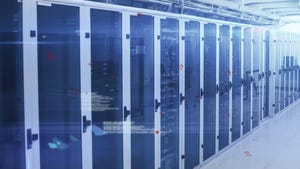AFCOM: ‘Boundless Possibilities’ as AI Transforms Data Center InfrastructureAFCOM: ‘Boundless Possibilities’ as AI Transforms Data Center Infrastructure
AFCOM’s latest State of the Data Center Report highlights unprecedented growth and looming challenges as the industry scales amid the AI gold rush.

AI is transforming the way data centers are designed, constructed, and operated, marking a “foundational change” in how humans engage with information, according to AFCOM’s latest State of the Data Center Report.
Published last week, the report (registration required) examines the profound impacts these shifts are having on the data center industry, from rising labor, supply chain, and security challenges to opportunities for innovation in sustainability – such as water conservation measures and the growing adoption of nuclear, solar, and other carbon-free energy solutions.
New Data Construction Takes a Hybrid Approach
According to AFCOM’s 2025 State of the Data Center Report, operators plan a sixfold increase in data center construction in the next three years, with an average facility size of 32 MW. How will these data centers be built? A third of all respondents identified a hybrid approach, pairing traditional construction methods with prefabricated modular data center solutions.
More than 80% of respondents plan to use IT modules as a prefabricated design component – up from 39% last year – with the same number eyeing prefabricated cooling modules.
“These innovations accelerate deployment, enhance scalability, and minimize waste – addressing both speed-to-market demands and environmental concerns,” said report author and Data Center World Program Director Bill Kleyman.
Secondary Markets Emerge as a Growing Trend
As primary markets become saturated, data center developers are increasingly expanding into secondary regions, with hubs near existing tech corridors and areas already equipped with enough land and power infrastructure.
Andy Cvengros, co-lead of U.S. data center markets at JLL, recently told Data Center Knowledge the company is seeing continued growth in secondary markets, including Richmond, Virginia; south Dallas; west Chicago; Atlanta; Ohio; northern Indiana; and others.
“This is driven by power and land availability at a lower cost basis than the core markets,” he said.

Bill Kleyman leading a session at Data Center World 2024
Physical Threats to Critical Infrastructure Are Increasing
Among the most pressing security and infrastructure threats, ransomware reached the top of the list for the ninth consecutive year, with 60% of respondents – up from 54% – citing this as their top concern. But one number jumped out in AFCOM’s assessment of security threats: 57% of respondents highlighted physical security threats, a 17% increase from last year. Seventy-eight percent of data center leaders reported changes to physical security requirements for their data centers in the past 12-24 months, including surveillance and monitoring (48%), and heightened vendor and contractor vetting processes (48%), highlighting the importance of consistently updating physical infrastructure security protocols.
Supply Chain and Labor Shortages Persist
The report highlighted another challenge facing the data center industry that hasn’t gone away: 85% of data center leaders report talent shortages affecting operations. Another growth challenge: 74% of respondents report ongoing supply chain constraints, with 16% noting these shortages caused facility outages.
“The message is clear: adaptability and forward-thinking are essential,” the report states.
Sustainability is a ‘Cornerstone of Future-Ready Data Centers’
The “staggering” scale of demand facing data centers has led to increased scrutiny of sustainability practices and the adoption of renewable energies.
AFCOM found that 71% of respondents have implemented, or plan to implement, projects to manage water and energy consumption, with nearly three-quarters of data center leaders looking to utilize renewable energy.
Of these initiatives, Kleyman called the push for water conservation “inspiring,” pointing to solutions such as direct-to-chip cooling and rear-door heat exchangers. And then there’s nuclear power. Although Kleyman cautions that this technology is not yet proven as economically viable, 33% of respondents believe SMRs and nuclear power will be central to their renewable energy strategy, up 12% from last year, and second only to solar (at 55%).
Sustainability can’t merely be an afterthought. “The future of data center design isn’t just about meeting demand – it’s about transforming the industry into a model of innovation and responsibility,” Kleyman told Data Center Knowledge, citing the need for collaboration between data centers and energy providers, regulators, and local communities.
He sounded an optimistic note: “From hybrid prefabrication to smarter materials, the possibilities are boundless.”
About the Author
You May Also Like









